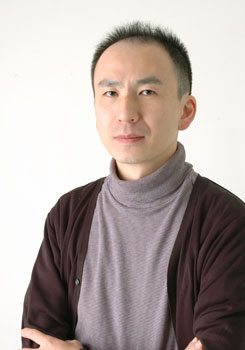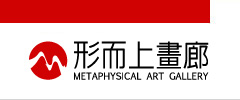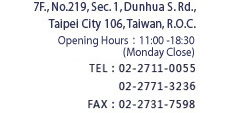|
 |
|
| |
 |
 |
 |
| |
Japanese artist Chiharu Nishizawa, who was born in 1970 in Nagano, graduated from the Department of Fine Arts (Art and Design), Tokyo Zokei University and majored in painting. Then, Nishizawa changed his major to printmaking. After Nishizawa got his master degree, he did works related to the printmaking for a period of time. The effect of flat coloring of the printmaking has in fact deeply influenced his art style.
Printmaking has a long history in Japan, especially for the ukiyo-e printmaking in Japanese Edo period. In addition to the historical figures and the folks legends, the life styles of the society and the ways ordinary people led at the time are also themes of the works. The "Civilian culture" is basically a record of the aspects of the lives of the peoples at the time. The two dimensional icon-ized performances had influenced French impressionism in 19th century and the later impressionism artists. Chiharu Nishizawa combines his skills of printmaking which he learned from the art school with the ukiyo-e and even introduced the western pop art and the forms of digitalized on-line game virtual spaces into his art works. |
|
 |
| |
|
The reason why Chiharu Nishizawa is getting more and more well-known in China is because of the special-made piano he and Steinway & Sons built together. The piano utilizes his art on the cover. That means the piano becomes a unique piece of art. Because of the high price and the co-work of a famous brand and an artist, it arouses a hot topic in the fashion circle in China. The special-made piano, which is named "The river of the sound”, is designed for the celebration of 10th anniversary of the establishment of Steinway & Sons Japan branch. Chiharu Nishizawa lays a piece of waves representing the blue ocean to interact with his icon-ized mini figures. He uses the water flow as the metaphor of the music flow and shows the elegant rhyme in serenity.
To see the works of Chiharu Nishizawa, we usually see the world of many lives yet with enormous sense of loneliness. Though the white space is left in the screen, and sometimes the white color is replaced with other monochrome, a space without being vacuumed, it is nothing but a virtual world. The people whose faces are blurred are also like symbols of some icons. The cities are like building blocks, the plants are like decorations, the streets are like mazes and the people are like ants who are acting without personalities in it. Everything is icon-ized in the picture. It is like a scene in a video game. Even the picture is indicating some event that is happening right now, lives seem to move on in silence in the huge virtual world of vacuum. Through the paintings of Chiharu Nishizawa, we can realize that when facing lives, human are guided by an invisible force. The regulation must be existing in the universe guiding us. That is the destiny that no one can change no matter how hard we try.
In the extremely flat space, the people in the city wearing the same uniform as if they were chessmen on a chessboard. They are controlled by their fates. This is the inescapable life of modern Japanese in the fast-paced society. There is nothing like the romantic life described in the traditional ukiyo-e. The pictures of Chiharu Nishizawa are the life fables he wrote for nature and human, for the East and the West, for the modern and the ancient, for the spirit and the objects, for wars and peace. From normal social phenomenon to private family life, Chiharu Nishizawa has something to say. Therefore, beneath the beautiful colors of his paintings, each piece has a deep fable in it. These propositions are originally philosophical. However, with Chiharu Nishizawa's arrangement, they are turned into mysterious game scenes which make it hard to understand the ideas of the creators with a simple look.
Chiharu Nishizawa is a master of colors. The colors he uses are splendid yet extremely elegant, old but modern, pleasant and thought-provoking. To put it in a more proper way, he is a magician of colors. Chiharu Nishizawa is a modern Japanese artist, or rather one of the most representative Asian artists. His lines and the colors are oriental. The contents in his works are the reflection of the common memory of economics taking-off – an anxiety that cannot be hidden under the expectation. His works also reflects the modern events which include the Global Climate Conference, the upcoming World's Fair, the military competition, the hegemony of the international policies, the family relationship in the fast-paced society and the artists' anxiety to all kinds of social critiques. All of these have been wrapped under his talented and beautiful sugarcoat of colors.
When getting in & out with the viewpoints of Chiharu Nishizawa, we can find that the most thing he wants to share with the viewers are all kinds of the fables of lives. What is more, under the skin of elegance, there is an enormous power hidden inside the serenity and analyzing the complex philosophy.
Victoria Lu
|
|
| |
|
| |
|
 |
|
| 1970 |
Born in Nagano, Japan. |
| 1993 |
BA in Painting, Department of Fine Arts (Art and Design), Tokyo Zokei University. |
| 1995 |
Completed Post-Graduate Course in Printing, Department of Fine Arts, Tokyo Zokei University. |
| |
|
Solo Exhibitions - |
| 2015 |
"Wonderland", Metaphysical Art Gallery, Taipei, Taiwan. |
| 2011 |
"FAMILY TREE ~look at life from both sides~" Tokyo Gallery + BTAP (Tokyo, Japan). |
| 2010 |
“Exodus--- Where are you from?”, Metaphysical Art Gallery, Taipei, Taiwan. |
| 2007 |
“For beautiful humanlife”, Tokyo Gallery+BTAP, Tokyo, Japan. |
| 2006 |
“Dream House”, do ART Gallery, Seoul, Korea.
“Enjoy Car Life”, Amelia Johnson Contemporary, Hong Kong. |
| 2005 |
“happy garden”, TOKYO GALLERY, Tokyo, Japan. |
| 2003 |
“project N”, ART GALLERY TOKYO OPERA CITY, Tokyo, Japan. |
| 2002 |
“Local Artists Exhibition”, Kamiyamada Cultural Hall, Nagano, Japan.
“Diorama”, Gallery Gen, Tokyo, Japan. |
| 2001 |
“Anotherday”, Gallery Yamaguchi, Tokyo, Japan. |
| 2000 |
“Prints”, Gallery Gen, Tokyo, Japan. |
| 1999 |
Harajuku Gallery, Tokyo, Japan. |
| 1998 |
Gallery Gen, Tokyo, Japan. |
| 1997 |
Gallery Gen, Tokyo, Japan. |
| 1995 |
Gallery Alies, Tokyo, Japan. |
| |
|
Group Exhibitions - |
| 2014 |
"micro salon 2014", Tokyo Gallery + BTAP (Tokyo, Japan). |
| 2013 |
"micro salon 2013", Tokyo Gallery + BTAP (Tokyo, Japan). |
| |
Taipei International Art Fair 2013 "Glorious Encounter" in Taipei World Trade Center (Taipei,Taiwan). |
| 2012 |
"micro salon 2012", Tokyo Gallery + BTAP (Tokyo, Japan). |
| 2011 |
Future Pass - From Asia to the World " Abbazia di San Gregorio (Venice, Italy),
Wereldmuseum Rotterdam (Rotterdam, The Netherlands), National Taiwan Museum of Fine Arts (Taipei,Taiwan). |
| 2010 |
"micro salon 60", Tokyo Gallery + BTAP (Tokyo, Japan). |
| |
"Japanese Colors" Gallery IHN (Seoul, Korea). |
| 2009 |
"Animamix Biennale" Museum of Contemporary Art Shanghai (China) |
| 2008 |
“Milestones”, TokyoGallery+BTAP, Beijing, China |
| 2007 |
“B.T.A.P. 5th Anniversary – Works in progress”, TokyoGallery+BTAP, Beijing, China.
“Thermocline of Art –New Asian Waves-“, ZKM Center for Art and Media Karlsruhe, Germany.
“Zokei Contemporary Artists” , Tokyo Zokei Univ. Yokoyama Memorial Manzu Art Museum, Tokyo, Japan.
“ART LAN@ASIA –New Asian Contemporary Art!”, ZAIM, Yokohama, Japan. |
| 2006 |
“Joy of Spring Light”, TOKYO GALLERY, Tokyo, Japan. |
| 2004 |
“The Vision of Contemporary Art 2004”, Tokyo, Japan. |
| 2003 |
“Art Jam”, Gallery Yamaguchi, Tokyo, Japan.
“Play not play”, B.T.A.P., Beijing, China.
“gallery review”, Art Space RASHINNBANN, Tokyo, Japan. |
| 2001 |
“The 6th Contest for the Best Contemporary Art Work 2001”, SOKO Gallery, Tokyo, Japan.
“Hanga-teki”, Naruse Bijutsu-Za, Tokyo, Japan. |
| 2000 |
“The 5th Contest for the Best Contemporary Art Work 2001”, SOKO Gallery, Tokyo, Japan. |
| 1998 |
“Art Studio Itsukaichi Residence Artist Exhibition”, Kirara Hall, Tokyo, Japan. |
| 1995 |
Four-person show, Shinkin Gallery, UedaCity, Nagano, Japan.
Three-person show, Gallery Showa-kura, Chikuma City, Nagano, Japan.
“TEN”, Kanagawa Kenmin Hall, Kanagawa, Japan. |
| 1994 |
Two-person show, Gallery Showa-kura, Chikumi City, Nagano, Japan.
Four-person show, Art Space 21, Tokyo, Japan. |
| 1993 |
“The 4th Poster Competition”, Maison Franco-Japonaise, Tokyo, Japan.
“The 2nd Sapporo International Print Biennial”, Hokkaido Museum of Modern Art, Sapporo, Japan |
| |
|
| Awards - |
|
| 2004 |
Honorable mention at “The Vision of Contemporary Art 2004”, Tokyo, Japan.
Awarded prize at “Shinshu Print-making Exhibition”.
|
| 1995 |
Awarded prize at “Shinshu Print-making Exhibition”.
Awarded prize at “The 4th Poster Competition,” Maison Franco-Japonaise,Tokyo, Japan.
|
| 1993 |
Awarded prize at “The 2nd Sapporo International Print Biennial”, Sapporo, Japan. |
| 1991 |
Awarded prize at “Shinshu Print-making Exhibition”. |
|
|
|
| |
|
|







